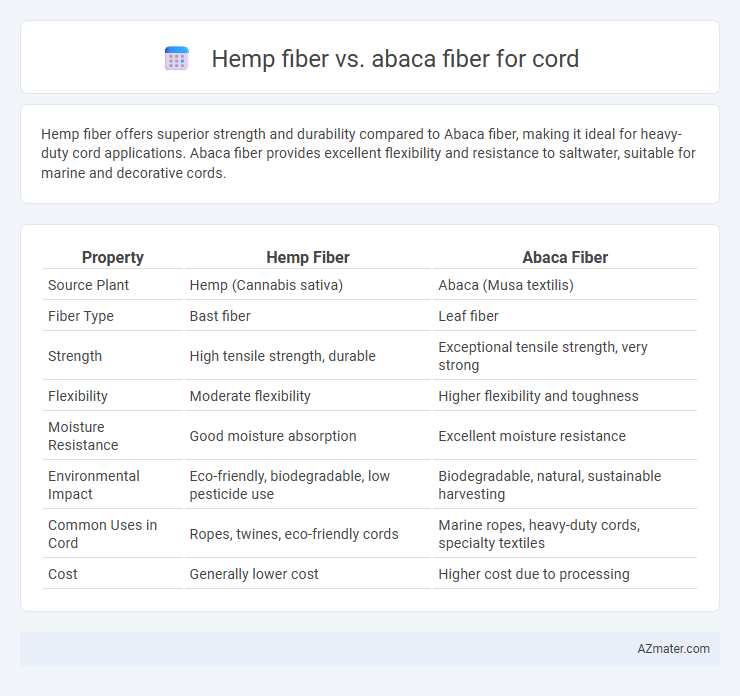Hemp fiber offers superior strength and durability compared to Abaca fiber, making it ideal for heavy-duty cord applications. Abaca fiber provides excellent flexibility and resistance to saltwater, suitable for marine and decorative cords.
Table of Comparison
| Property | Hemp Fiber | Abaca Fiber |
|---|---|---|
| Source Plant | Hemp (Cannabis sativa) | Abaca (Musa textilis) |
| Fiber Type | Bast fiber | Leaf fiber |
| Strength | High tensile strength, durable | Exceptional tensile strength, very strong |
| Flexibility | Moderate flexibility | Higher flexibility and toughness |
| Moisture Resistance | Good moisture absorption | Excellent moisture resistance |
| Environmental Impact | Eco-friendly, biodegradable, low pesticide use | Biodegradable, natural, sustainable harvesting |
| Common Uses in Cord | Ropes, twines, eco-friendly cords | Marine ropes, heavy-duty cords, specialty textiles |
| Cost | Generally lower cost | Higher cost due to processing |
Overview of Hemp Fiber and Abaca Fiber
Hemp fiber is derived from the stalks of the Cannabis sativa plant, known for its exceptional strength, durability, and resistance to mold, making it ideal for cord and rope manufacturing. Abaca fiber, sourced from the leaf stalks of the Musa textilis plant native to the Philippines, offers superior flexibility and high tensile strength, commonly used in marine ropes and specialty cords. Both fibers are sustainable natural materials, with hemp providing greater abrasion resistance while abaca excels in wet environments due to its moisture resistance.
Botanical Origins and Cultivation
Hemp fiber, derived from the stalks of Cannabis sativa, thrives in temperate climates with minimal pesticide requirements, promoting sustainable cultivation through rapid growth and soil regeneration. Abaca fiber stems from the Musa textilis plant, native to the Philippines, flourishing in tropical environments with high humidity and well-drained soils, and is traditionally harvested by hand for its long, strong fibers. Both fibers exhibit distinct botanical origins and cultivation practices that significantly influence their mechanical properties and environmental impact in cord manufacturing.
Fiber Extraction Methods
Hemp fiber extraction primarily employs retting processes, including water retting and dew retting, that dissolve pectins binding the fibers to the stalk, leading to finer and more flexible fibers ideal for cordage. In contrast, abaca fiber extraction involves decortication, mechanically stripping the outer layers of the Musa textilis plant to obtain long, strong fibers with superior tensile strength, commonly used in heavy-duty ropes and marine cords. The differing extraction techniques directly influence fiber quality, durability, and application, with hemp favoring environmentally friendly retting and abaca relying on mechanical separation to yield robust, coarse fibers.
Physical Properties Comparison
Hemp fiber exhibits higher tensile strength and durability compared to abaca fiber, making it ideal for heavy-duty cords requiring long-lasting performance. Abaca fiber offers superior flexibility and moisture resistance, enhancing its suitability for ropes and cords used in wet environments. Both fibers provide excellent abrasion resistance, but hemp's coarser texture contributes to greater overall robustness in demanding applications.
Strength and Durability for Cordage
Hemp fiber exhibits high tensile strength and resistance to abrasion, making it ideal for durable cordage in heavy-duty applications. Abaca fiber surpasses hemp in flexibility and water resistance, offering superior durability in marine environments and prolonged exposure to moisture. Both fibers provide robust options for cord strength, with hemp excelling in rigidity and abaca in resilience under wet conditions.
Flexibility and Texture Differences
Hemp fiber offers high flexibility and a coarse texture, making it highly durable and resistant to wear for cord applications. Abaca fiber is stiffer with a smoother but slightly brittle texture, providing superior strength but less elasticity compared to hemp. The choice depends on the required balance between flexibility and toughness in the cord's end use.
Resistance to Moisture and Mildew
Hemp fiber demonstrates superior resistance to moisture and mildew compared to abaca fiber, making it an ideal choice for cord applications exposed to damp environments. Abaca fiber, while strong and flexible, is more susceptible to mildew and moisture damage due to its higher absorbency rate. This moisture resilience of hemp fiber ensures longer-lasting durability and reduced maintenance in humid or wet conditions.
Sustainability and Environmental Impact
Hemp fiber demonstrates exceptional sustainability due to its rapid growth cycle, low water requirements, and natural pest resistance, reducing the need for harmful agrochemicals. Abaca fiber, sourced from the banana plant's leaf stalks, offers biodegradability and high tensile strength while utilizing agricultural waste, which minimizes environmental footprint. Both fibers contribute to eco-friendly cord production, but hemp's regenerative qualities and carbon sequestration potential give it a superior advantage in environmental impact.
Common Applications in Cord Manufacturing
Hemp fiber is widely used in rope and cord manufacturing due to its high tensile strength, durability, and resistance to UV damage, making it ideal for marine ropes, climbing cords, and agricultural twines. Abaca fiber, derived from the Musa textilis plant, excels in producing lightweight, flexible cords with superior resistance to saltwater and abrasion, commonly used in specialty ropes, fishing lines, and durable packaging cords. Both fibers are favored for their biodegradable properties, yet hemp offers broader industrial applications while abaca suits marine and fishing-related cord production.
Cost and Market Availability
Hemp fiber offers a cost-effective solution for cord production due to its widespread cultivation and renewable nature, making it more accessible in global markets. Abaca fiber, while generally more expensive, is valued for its superior strength and resistance to saltwater, but its limited geographic cultivation restricts large-scale availability. Price fluctuations in abaca fibers are influenced by regional harvest yields, whereas hemp benefits from established industrial farming and stable supply chains.

Infographic: Hemp fiber vs Abaca fiber for Cord
 azmater.com
azmater.com